
Dolphin constellation is actually one of the smallest constellations in the northern hemisphere. It occupies only 189 square degrees, making it the 69th largest constellation.
Its shape resembles that of a kite and it is surrounded by the neighboring constellations Fox, Little Horse, Aquarius, Eagle, Arrow, and Pegasus.
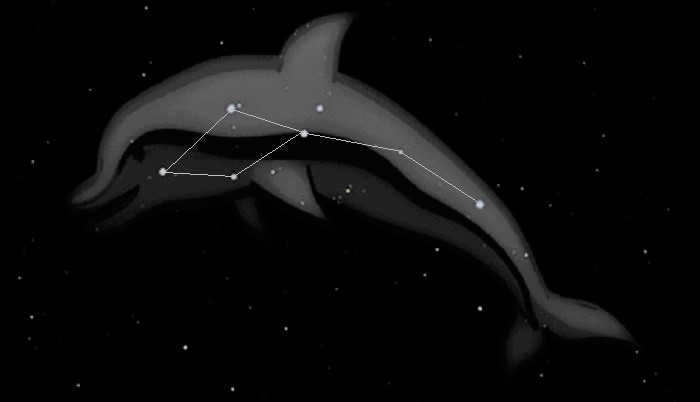
Legend of the Dolphin Constellation
As an ancient constellation, the Dolphin has its own mythological origins, with multiple versions describing its creation.
According to one tale, the Dolphin constellation is associated with the ancient Greek dolphin. This dolphin aided Poseidon in marrying the nymph Amphitrite, for which the sea god granted the dolphin a place in the heavens.
In another story, the Dolphin saved Apollo’s life, and in gratitude, Apollo immortalized the dolphin in the stars.
The Dolphin represents a helpful and loyal servant deserving of gratitude.
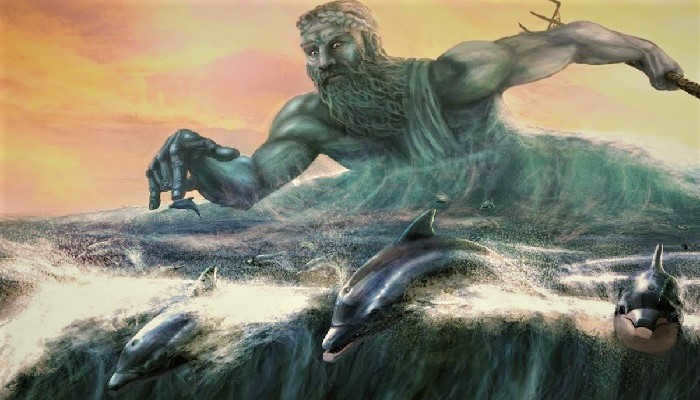
Which stars form the constellation Dolphin.
Alpha and Beta of Dolphin were named after the astronomer Nikolaus Venator who included them in the star catalog. However, their names are spelled backwards.
Alpha star Sualocinus is actually a multiple system. In fact, it consists of seven objects and is the brightest in the area.
Beta is a double luminosity star called Rotanev, which is composed of a giant and a subgiant.
Gamma is also a double star, similar to Beta. It includes a yellow-white dwarf and an orange subgiant. It is speculated that the second star may have a planet in its orbit.
Delta and Epsilon are both giants and variable stars.
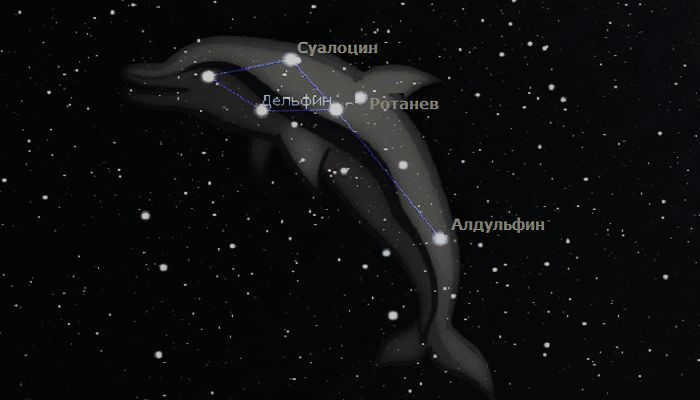
What other secrets does the Dolphin constellation hold?
Hidden within the boundaries of the Dolphin constellation are two petite planetary nebulae: NGC 6891 and NGC 6905. Interestingly, the latter is commonly known as the Blue Flash Nebula, presumably due to its distinct coloration.
Furthermore, astronomers have discovered the presence of globular clusters in this region:
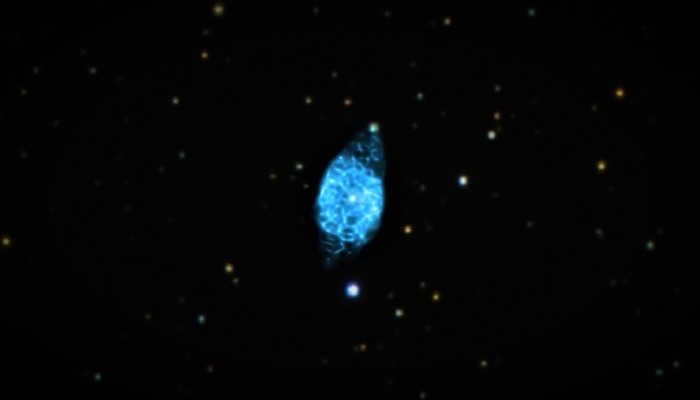
- There is a vast collection of stars known as NGC 6934 that is situated in close proximity to the Epsilon constellation;
- It is worth mentioning that NGC 7006 can be found near the Gamma star and it is a part of our very own Milky Way galaxy.
Moreover, the Dolphin constellation also encompasses the pattern known as Job’s Coffin. This arrangement resembles a tiny diamond shape. It is created by the stars: Alpha, Beta, Delta, and Gamma.
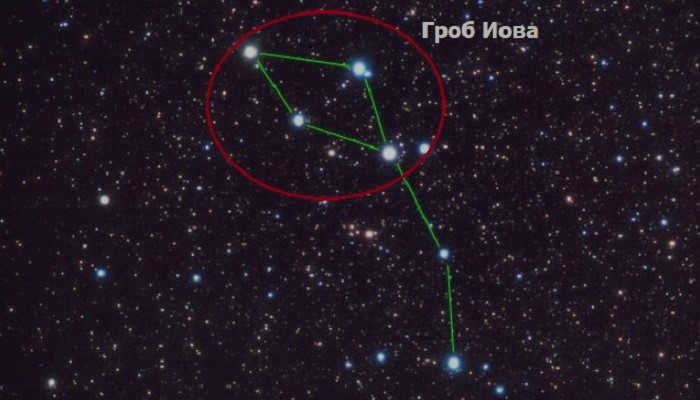
Overview
Astronomers state that the Dolphin constellation can be observed from almost any location on Earth except for Antarctica. The prime time to view it is between June and September. It’s advisable to search for it in latitudes ranging from +90 to -69.
It’s important to mention that scientists closely monitor the constellation. For instance, in 2013, they witnessed the eruption of Nova Delphinus 2013. It could be spotted in the night sky without the aid of instruments.
Based on the current data, there have been three such stars in the vicinity. To date, 339 variable luminaries have been documented in the Dolphin region. As you can see, the constellation offers an abundance of intriguing objects.
The Delphinus constellation represents the marine creature sent by Poseidon in search of the nerid Amphitrite, whom he desired to marry. Ptolemy included it in his list of constellations in the second century. It contains a number of fascinating celestial objects, including the globular clusters NGC 6934 and NGC 7006, as well as the planetary nebulae NGC 6891 and NGC 6905.
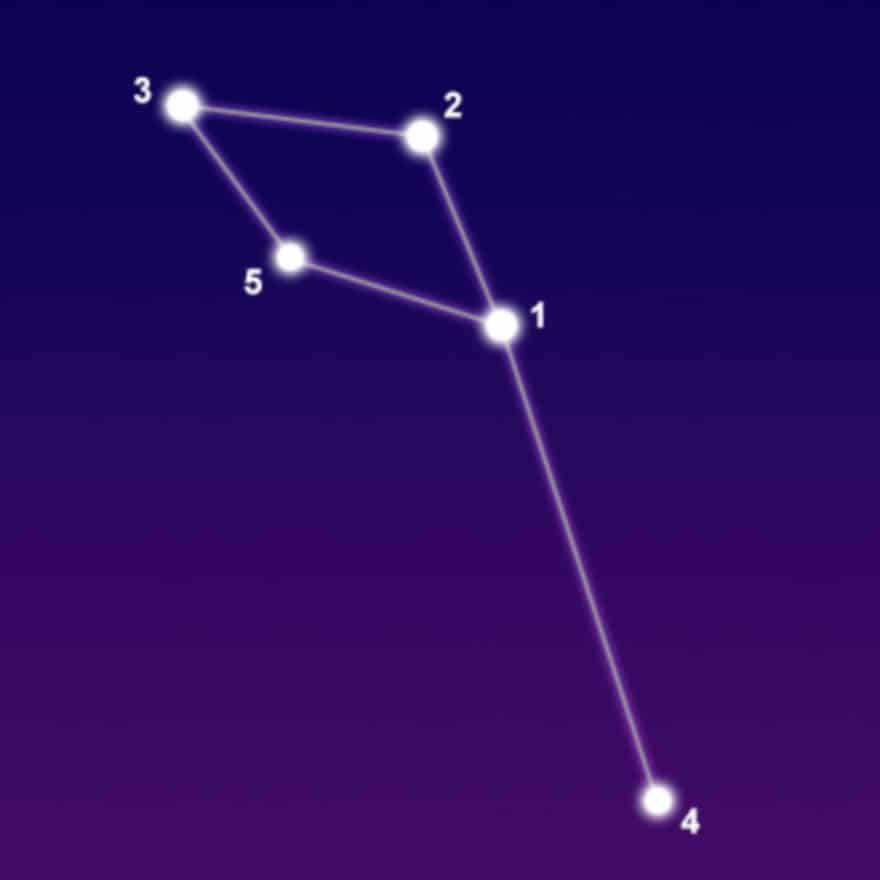
Facts, Position, and Map
The constellation Dolphin is ranked 69th in size, covering an area of 189 square degrees. It is located in the fourth quadrant of the northern hemisphere (NQ4) and can be found at a latitude ranging from +90° to -70°. Dolphin is bordered by Aquarius, Pegasus, Arrow, Lesser Horse, Eagle, and Foxy.
The brightest star in Dolphin is Sualokin (α Del) with a magnitude of 3.77m.
Dolphin contains 5 stars with planets and does not have any Messier objects or meteor streams. The brightest star in the constellation is Beta Delphinus. It is part of the Celestial Waters constellation group, which also includes Stern, South Fish, Eridanus, Little Horse, Dove, Kiel, Compass, and Sails. You can explore a star map to see the positions of Dolphin’s stars, objects, and neighboring constellations.
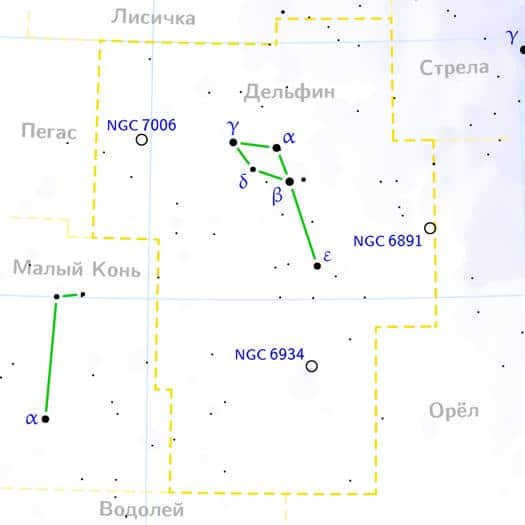
Legend
There are two legends associated with the constellation Dolphin. According to one legend, the dolphin was a messenger of the sea god Poseidon. Poseidon fell deeply in love with the nymph Amphitrite and desired to court her. However, Amphitrite resisted his advances and sought refuge among her sisters. In an effort to find Amphitrite, Poseidon sent messengers, and it was the dolphin who eventually discovered her. The dolphin calmed Amphitrite and escorted her to Poseidon, leading to their eventual marriage. As a sign of gratitude, Poseidon immortalized the dolphin by placing it among the stars.
There is another tale involving Apollo’s dolphin. This particular dolphin was the deity of poetry and music. The dolphin had a special mission to rescue the poet and musician Arion, who resided on the island of Lesbos. Arion was traveling through Italy with his lyre and was on his way back to Greece by ship. However, the sailors on board, driven by greed, plotted to murder him and steal his earnings. As Arion found himself surrounded by the sailors, he made a request to play his lyre and sing one last time. Surprisingly, the sailors agreed. The music that flowed from Arion’s instrument was so beautiful that it captivated the attention of a few dolphins. Feeling resigned to his fate, Arion made the bold decision to jump overboard. One of the dolphins swiftly came to his aid and carried him all the way to Greece. In due course, Arion brought justice upon the treacherous sailors by sentencing them to death. The constellation Dolphin can be found alongside Lyra as a tribute to Arion’s significant contribution to this story.
Main celestial bodies
Discover the celestial bodies of the constellation Dolphin with in-depth explanations and classification.
Alpha Delphinus stands out as the most brilliant multiple star in the constellation, boasting a combined apparent magnitude of 3.77. This star system consists of seven components: A and G (physical pair), B, C, D, E, and F are considered optical doubles.
A and G are situated approximately 241 light-years away and are classified as spectral types A and B9V respectively.
This star system is also known as Sualocinus, a name given by Italian astronomer Nicolo Cacciatore. It is actually a reverse spelling of his own name, Latinized for astronomical purposes.
The term “Rotanev” is an anagram of the surname Venator (the assistant of Giuseppe Piazzi) and signifies “hunter.”
Gamma Delphinus is a binary star situated at a distance of 101 light-years. The primary component is a yellow-white dwarf (F7V) and the secondary component is an orange subgiant (K1IV). The respective magnitudes are 5.14 and 4.27.
In 1999, a potential exoplanet was discovered in orbit around the secondary star, but no confirmation has been made thus far.
Delta Delphinus is a large star (A7IIIp) with a visual magnitude of 4.434. It exhibits variability and is known as Delta Shield.
Epsilon Delphinus is a giant of a bluish-white color (B6III) and has a visual brightness of 4.03 with a distance of 358 light years. It is a star that varies in brightness, with its magnitude periodically reaching 3.95. In Arabic, the name ānabab ad-dulfīn translates to “tail of the dolphin”. This name has also been translated into Latin as Cauda Delphini.
Rho Orla (Tso Ke) is a dwarf star of a white color (A2V) with an apparent brightness of 4.94 and a distance of 154 light-years. In Mandarin, “Tso Ke” translates to “left flag”. In China, the term “Left Flag” refers to the arrangement of stars formed by Ro Eagle and several other stars in the Sagittarius constellation. Ro Eagle itself is known as the Ninth Star of the Left Flag.
This star is estimated to be around 50 million years old. Until 1992, it was categorized as part of the Eagle constellation, but it was later reclassified as part of the Dolphin constellation.
Celestial entities
NGC 6934 (Caldwell 47) is a rather sizable globular cluster situated in close proximity to the celestial body known as Epsilon Dolphin. Boasting a visual magnitude of 8.83, this cluster is positioned a staggering distance of 50,000 light-years away. Its existence was first brought to light by the renowned astronomer William Herschel on September 24, 1785.
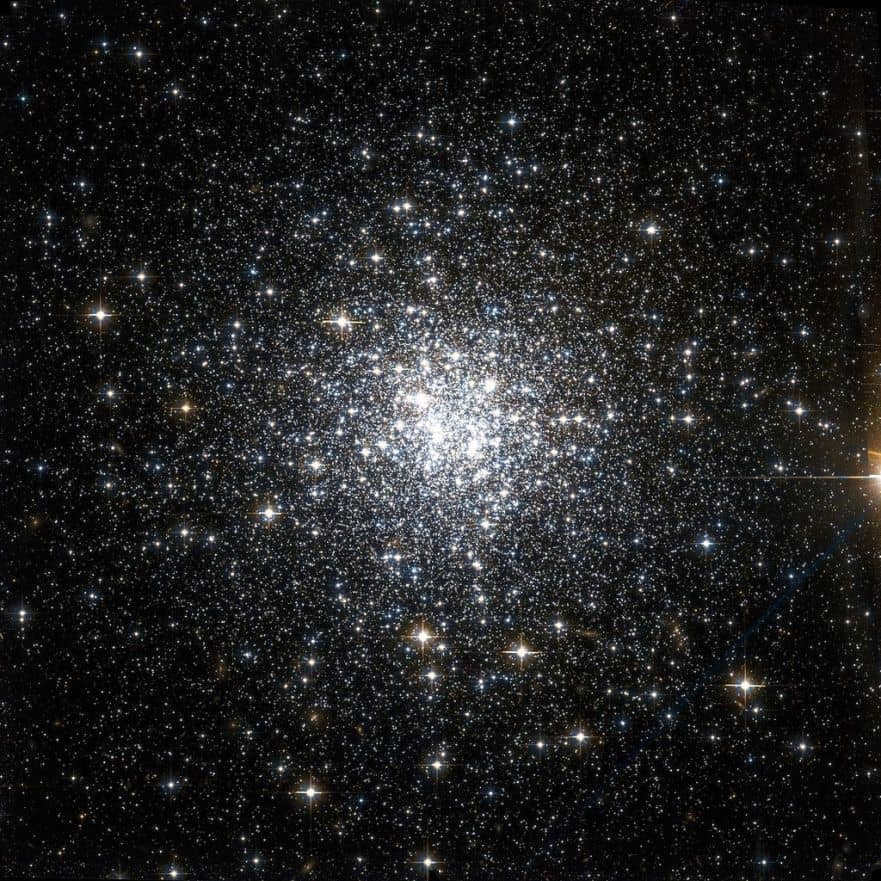
The NGC 6934 globular cluster is a stunning sight in the night sky.
NGC 6891, a small planetary nebula located near Rho Eagle, has a visual magnitude of 10.5.
If you have a 6-inch telescope, you can observe the beautiful bluish NGC 6905, also known as the Blue Flash, which is a small planetary nebula.
Located 137,000 light-years away from us, NGC 7006 (also known as Caldwell 42) is a globular star cluster situated on the outskirts of the Milky Way. With a visual magnitude of 10.6, it can be found near the star Gamma Delphinus.
This stunning cluster is part of the galactic halo, which is a spherical-shaped region of the Milky Way. The galactic halo is composed of various elements such as dark matter, gas, and even the occasional star cluster.
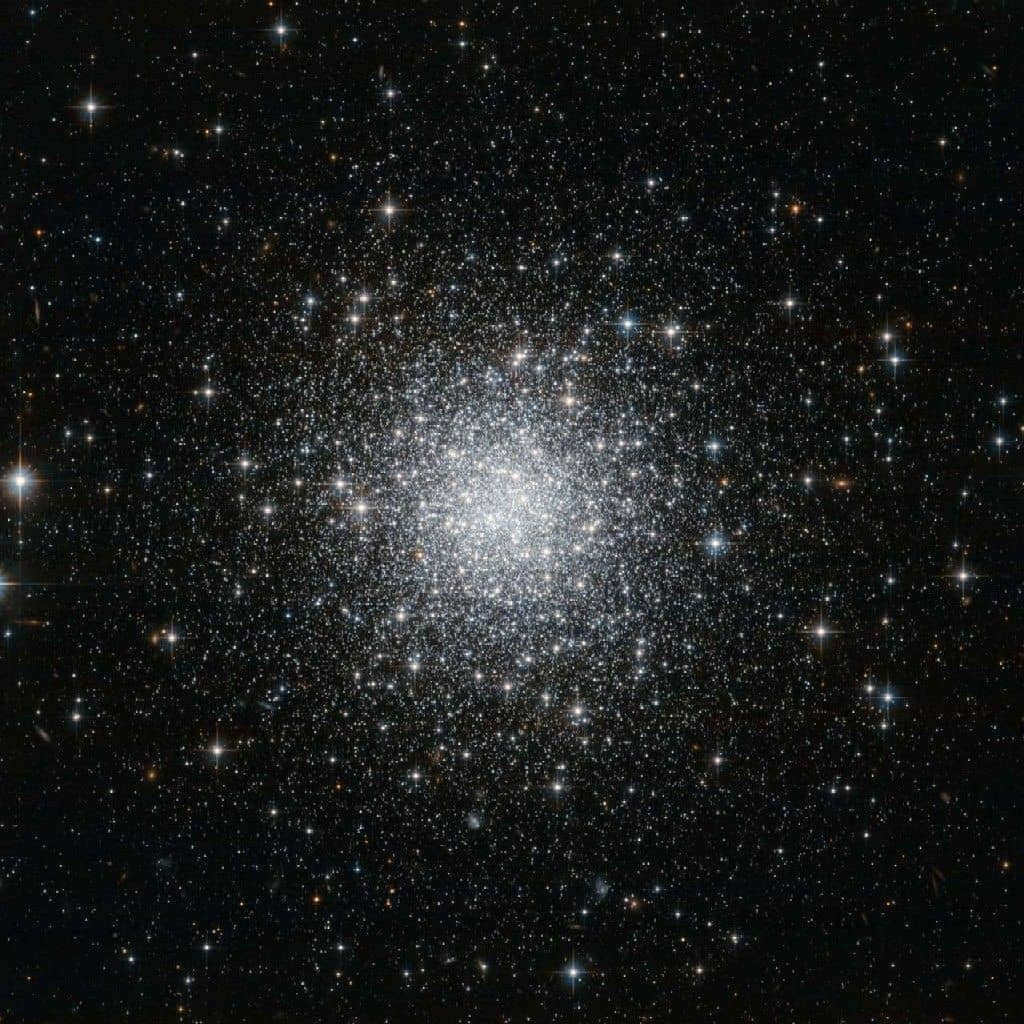
If you want to get a better understanding of the Dolphin constellation, you have the option to explore it using various resources, such as 3D models and online telescopes. Additionally, you can also use a static or interactive star map to aid in your personal exploration of this constellation.

- Constellations
The Dolphin – An insignificant constellation situated in the northern part of the celestial sphere, characterized by three prominent stars with a brightness of 3.7, 3.8, and 4.0 sidereal magnitude. Resembling the shape of a kite, The Dolphin can be found in close proximity to the summer-fall triangle neighboring Altair.
The primary celestial bodies of the Dolphin constellation are.
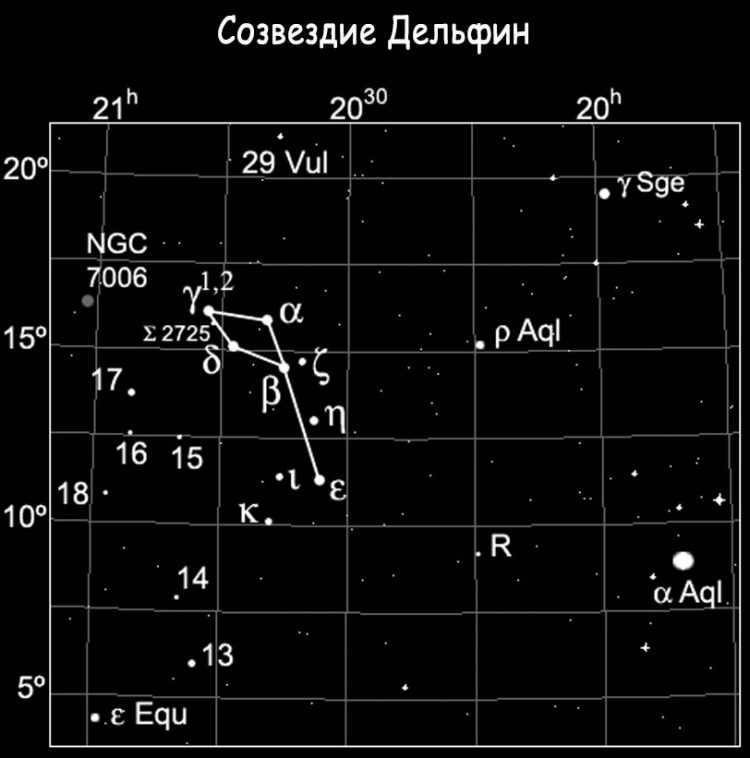
Sualokin or Dolphin α (Alpha Delphinus)
Alpha Delphinus-Sualokin. – is the most brilliant multiple star in the constellation with a total apparent magnitude of Z.77. It is a star of the B9 spectral class with a surface temperature of 11,000 K . Like most B-class stars, it rotates rapidly: the speed of rotation at the equator is 160 km/s (70 times faster than the Sun). At a distance of 240 light-years, the star seems to have a brightness 195 times that of the Sun.
The classification of Sualocin is somewhat uncertain, some believe it is a regular main-sequence star, others that it is a subgiant in the early stages of evolution.
In addition, the system contains at least 5 other components labeled as “a”, however, there is no indication that they are gravitationally linked to the primary stellar pair; they simply serve as visual companions.
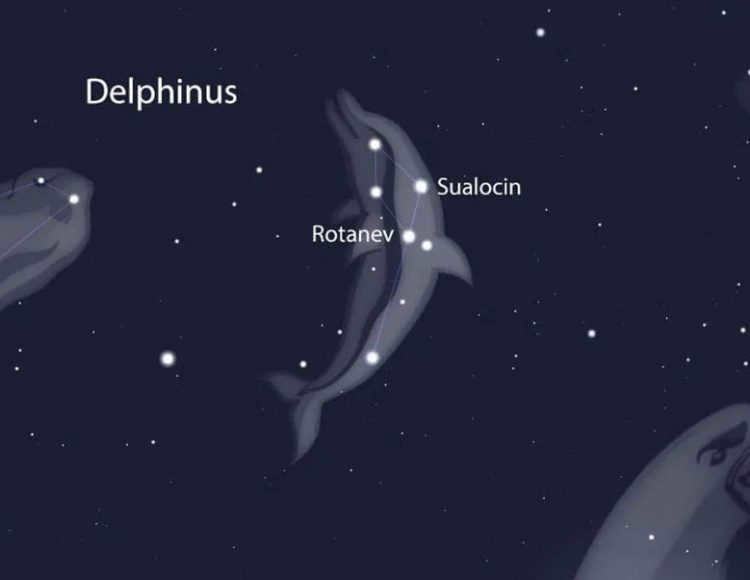
Rotanev or Dolphin β (Beta Delphinus)
Beta Delphinus (Rotanev). – A binary star discovered in 187Z by C. B. Burnham. This stellar system is approximately 1.8 billion years in age.
Approximately speaking, there are two subgiants in the system, belonging to the F5 spectral class and having a surface temperature of 6,500 K. The stars are in very close proximity to each other, making it impossible to distinguish them with a medium aperture telescope. On average, they are separated by 0.65 angular seconds, which is equivalent to the angular size of a coin from a distance of 10 km. The brighter star in the pair has a magnitude of fourth (4.0 m), while the other star is slightly fainter with a magnitude of 4.9 m. Considering the distance, their luminosities are 18 and 8 times that of the sun, respectively. The rotation speed of one or both stars is relatively slow, approximately 40 kilometers per second, which is 20 times higher than the rotation speed of the Sun. The stars orbit each other with a period of 26.66 years.
It is highly unlikely for any of these stars to have their own planets due to the potential instability of their orbits.
The Dolphin γ (Gamma Delphinus)
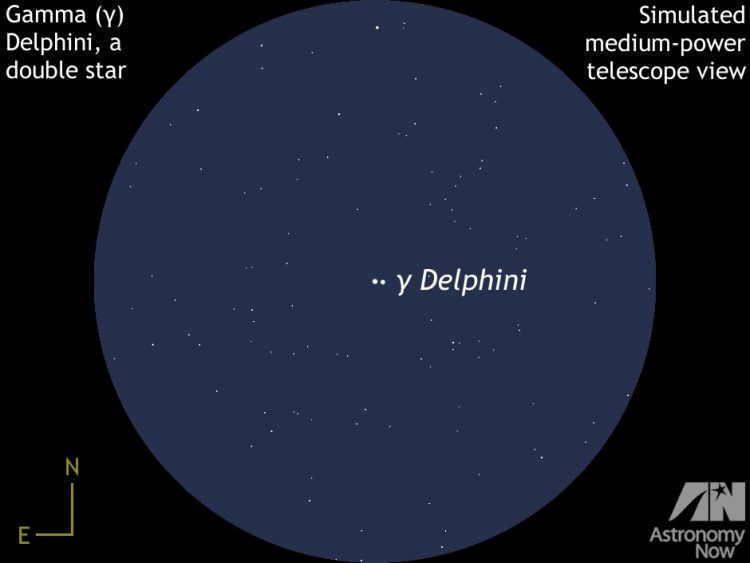
Gamma Delphinus is a binary star system situated 101 light-years away. It is widely recognized as one of the most prominent double stars and comprises of a fourth magnitude orange subgiant and a fifth magnitude white-yellow dwarf.
γ 1 Delphinus is a white-yellow dwarf with a spectral class F7V and an apparent magnitude of 5.14. The luminosity of this star is estimated to be seven times that of the Sun. γ 2 Delphinus is an orange subgiant with a spectral class K1IV and an apparent magnitude of 4.27. It is believed that this star possesses a luminosity of approximately 20.6 times that of the Sun.
In 1999, a potential exoplanet was discovered in orbit around the second component of the system, but no confirmation has been made thus far.
Dolphin δ (Delta Delphinus)
Delta Delphinus is a massive star categorized as an A7IIIp spectral type. It has an apparent magnitude of 4.434 and exhibits variability as a Delta Shield variable.
Dolphin ε (Epsilon Delphinus)
Epsilon Delphinus is a blue-white giant star with a spectral type of B6III. It has a visual magnitude of 4.0Z and is located at a distance of Z58 light-years. This star is known to be variable, with its brightness periodically reaching Z.95 magnitude. The Arabic term ānabab ad-dulfīn translates to “tail of the dolphin,” which has been translated into Latin as Cauda Delphini.
Po Eagle (Tso Ke)
Po Eagle (Tso Ke) is a white dwarf star (A2V) located approximately 154 light-years away with an apparent magnitude of 4.94. The name “Tso Ke” originates from Mandarin and translates to “left flag”. In China, “Left Flag” refers to a group of stars in the constellation of Sagittarius, including the Po Eagle, with the Po Eagle being recognized as the Ninth Star of the Left Flag. It is estimated to have an age of 50 million years. Prior to 1992, this star was categorized under the constellation Eagle, but it was later reclassified as part of Dolphin.
Engaging items to witness
1. NGC 6934 (C 47) – an assemblage of stars in a spherical shape
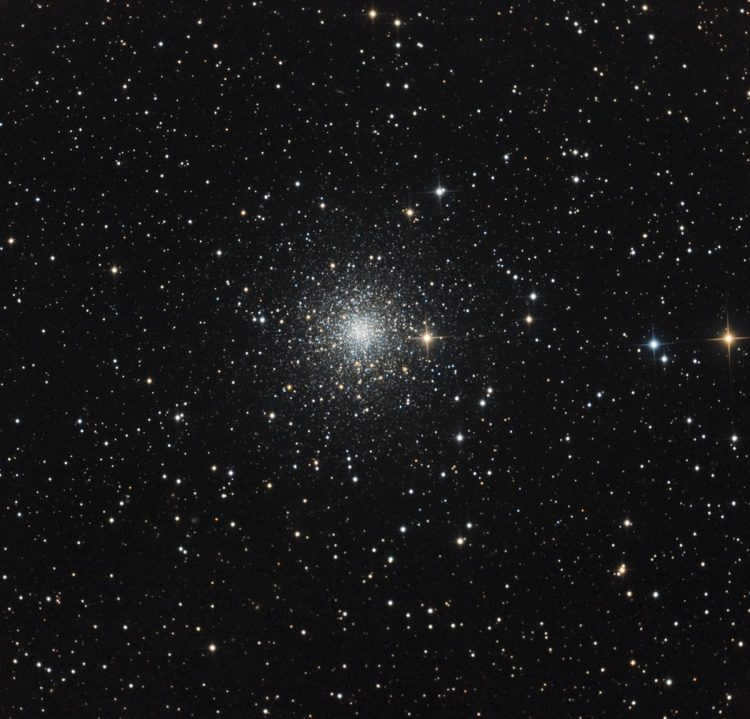
NGC 6934 is a compact group of stars known as a globular star cluster, and it has an apparent magnitude of 8.9 m. When viewed through a small amateur telescope, it appears as a slightly blurred spot that is slightly larger than a single star. To observe this cluster in more detail, a telescope with an aperture of at least 150 mm is recommended.
This globular star cluster can be found in the southern part of its constellation, and a good starting point for locating it is the star κ (kappa) Delphinus.
2. The celestial formation NGC 7006 (C 42)
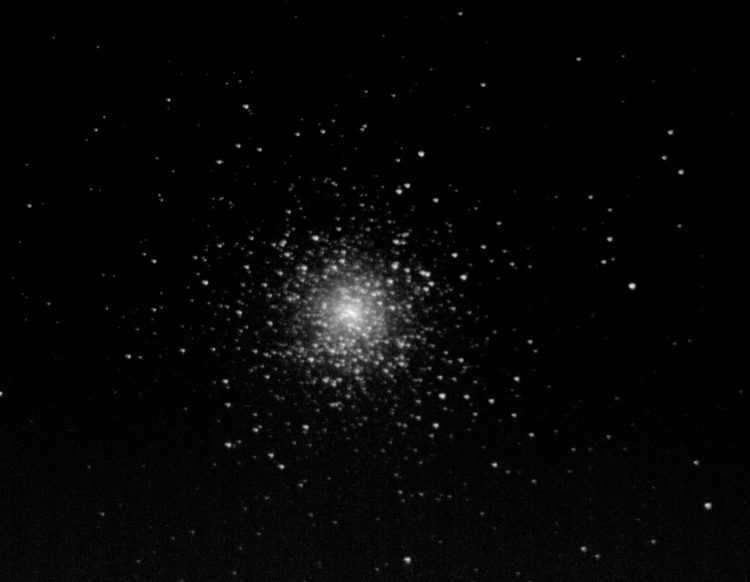
There is another globular star cluster that is abundant in the constellation of Dolphin. It is known as NGC 7006.
While some sources may indicate that its apparent stellar magnitude exceeds the 11th magnitude, this is not actually the case. The true brightness of NGC 7006 is 10.6 m. It is quite sizable, even larger than the previous cluster, and can be observed in detail using a telescope with a 150 mm objective diameter.
So, how can you locate NGC 7006? Look for a rhombus formation of bright stars in the sky and then move to the left from the leftmost star.
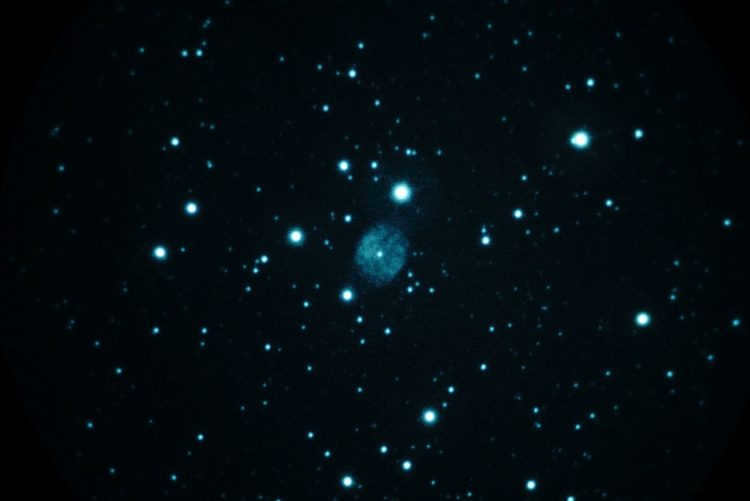
NGC 6905, also known as Blue Flash, is a compact nebula that can be effortlessly observed using a 6-inch telescope.
This planetary nebula was discovered in 1782 by William Herschel and surprisingly, it is accessible even through smaller telescopes. When observed with larger telescopes, it transforms from a faint beam to a breathtaking spectacle. A 15″ telescope clearly reveals a structure resembling the photograph above – a jagged oval enclosed within a trapezoid shape. Under dark skies and with the appropriate aperture, this nebula is truly a valuable find!
Search for the faint haze within the easily recognizable cluster of stars depicted in the images – the three stars forming the trapezoid can be easily distinguished with a 4″ telescope. Remember to utilize your peripheral vision.
4. NGC 6891: An Astounding Planetary Nebula
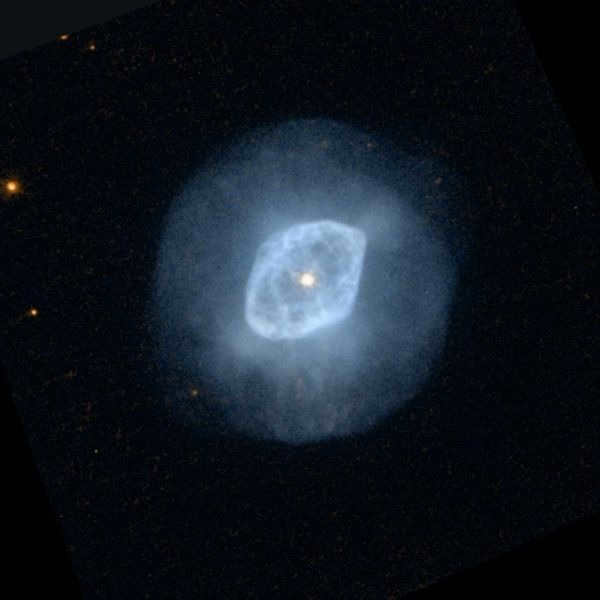
NGC 6891 – A planetary nebula with a small size, situated close to Rho Eagle and possessing an apparent magnitude of 10.5;
Discovering a constellation in the night sky
The Dolphin constellation holds the 69th position in terms of size in the celestial sphere, covering an area of 189 square degrees.
This constellation can be seen at latitudes ranging from -70° to +90°. The most favorable conditions for observation are during the months of June and August. The Dolphin constellation is clearly visible all across Russia. It is surrounded by the neighboring constellations of Arrow, Fox, Eagle, Aquarius, Lesser Horse, and Pegasus.
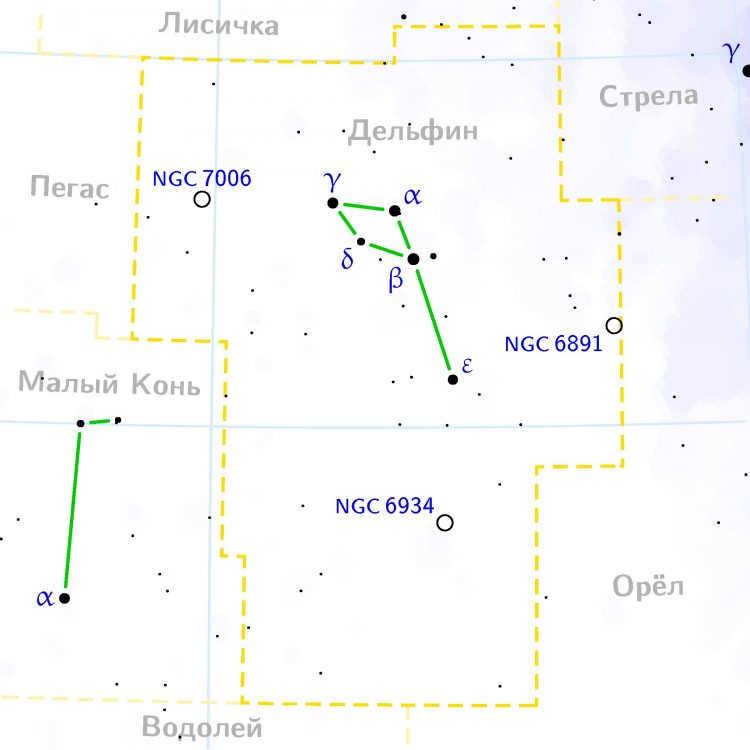
During autumn, the Dolphin constellation can be seen in the western part of the sky. It is positioned along a line connecting its stars Deneb (alpha Swan) and Altair (alpha Eagle), with a slight shift towards Altair. The Dolphin occupies the lowest position above the horizon throughout the year, making it easy to locate with the help of the “Summer Triangle”.
In winter, the Dolphin moves to the northeastern part of the sky and becomes visible in the morning. It fully appears above the horizon after 6 am. Finding the constellation is not difficult, as it is located to the left of the bright star Altair and at the same altitude as it.
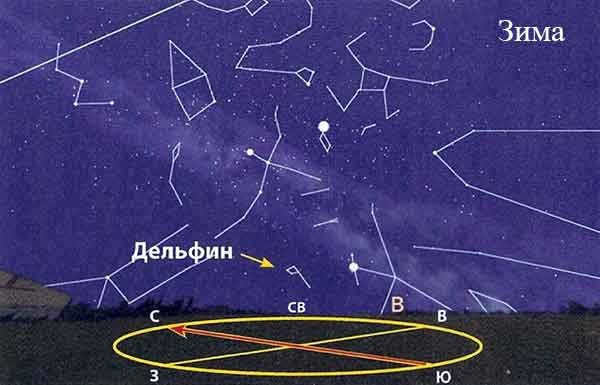
As summer comes to an end, the Dolphin constellation makes its way to the southern part of the sky, ascending to great heights. Amidst the vastness, the pair of stars known as the “Summer Triangle” – Deneb and Altair – stands out as a reliable guide to locating this celestial formation.
The Origins of the Dolphin Constellation
The Dolphin constellation has been a part of the night sky for centuries, first documented by Claudius Ptolemy in his catalog. This constellation takes on the shape of a rhombus, boasting four prominent stars with a magnitude of the fourth.
It is worth mentioning that α Delphinus is known as Sualocinus and β is known as Rotanev. These peculiar names have a rational justification. In 1814, the Palermo Observatory’s deputy director, Niccolo Cacciatore (Latin name Nicolaus Venator), bestowed these stars with his own name in reverse order as a tribute.
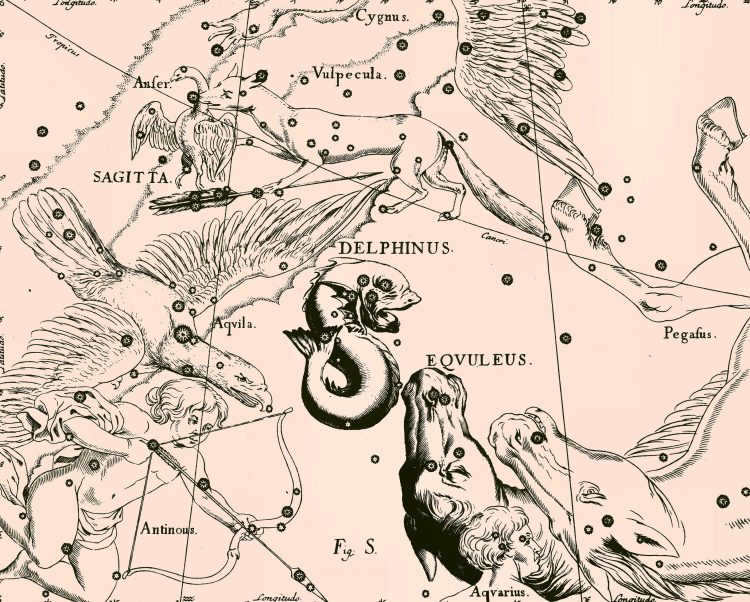
Legend of the constellation
The constellation Dolphin is associated with two legendary tales:
- The first story revolves around a dolphin, who serves as the messenger of Poseidon. The story goes that Poseidon, the god of the sea, fell deeply in love with Amphitrite. He tried to woo her, but she resisted his advances and hid among her sisters. In his pursuit of her, Poseidon sent messengers, and among them was Delphinus, the dolphin who guided the maiden to the enamored god. As a token of his gratitude, Poseidon immortalized Delphinus by placing him among the stars.
- The second tale revolves around Apollo, the god of poetry and music. Once, he found himself as the savior of a local poet and musician named Arion, who happened to be in Lesbos. Arion was on a tour in Italy and was returning to Greece by ship. However, the sailors, known for their greed, conspired to kill the famous artist. Before carrying out their plan, Arion requested that the sailors allow him to play and sing one last time. The music that flowed from his instrument was so melodious that it caught the attention of a group of dolphins. Inspired by this, Arion made a bold decision – to trust in fate and jump overboard. One of the dolphins came to his rescue and safely carried him back to Greece.
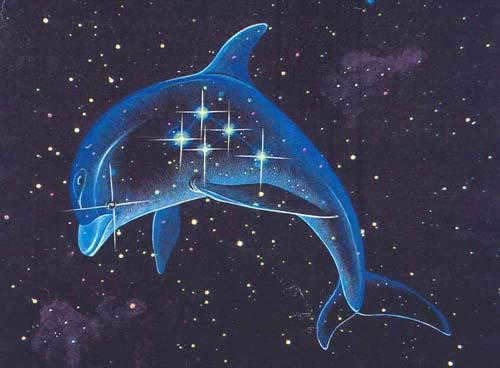
Legend
The legend of the Dolphin constellation originates from the ancient Greek mythology and is often told to children. According to one of the legends, Poseidon, the god of the oceans, fell in love with a nereid named Amphetrita. However, Amphetrita did not reciprocate Poseidon’s feelings and decided to escape from him. Fortunately, a kind-hearted dolphin came to her rescue and helped her return safely. As a token of gratitude, Poseidon rewarded the dolphin by placing it among the stars in the sky. Ever since then, the constellation Dolphin has been adorning the celestial dome.
Accommodation
Accommodation is a term that refers to the provision of a place to stay or live in. It can include various types of housing, such as houses, apartments, hotels, or hostels. Accommodation is an important aspect of travel and tourism, as it provides visitors with a place to rest and relax during their trip. It can also be a significant expense for travelers, so finding affordable and suitable accommodation is often a priority. There are many factors to consider when choosing accommodation, including location, cost, amenities, and reviews. It is important to research and compare different options to find the best accommodation for your needs and preferences.
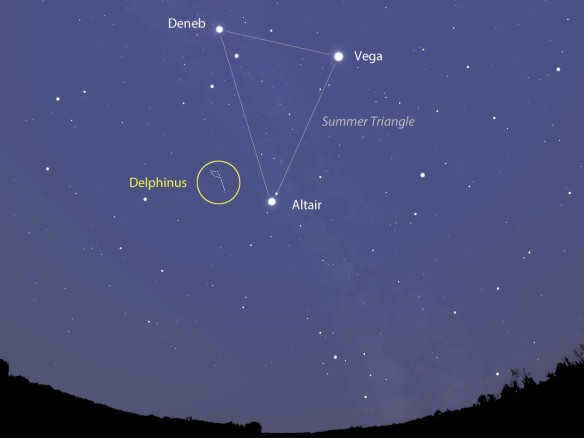
The Dolphin constellation is often overshadowed by its more prominent neighbors. Positioned near the Summer Triangle asterism, which includes the well-known stars Vega, Deneb, and Altair, Dolphin shares its celestial borders with other notable constellations such as Eagle, Pegasus, Arrow, Lesser Horse, Foxes, and Aquarius. It can be observed throughout most of Russia on clear nights, excluding the northernmost regions. The best time to view Dolphin is from June to September. Its distinctive kite-like shape makes it easily identifiable, assuming there are no hindrances like clouds or poor visibility conditions.
Asterism
The Dolphin constellation covers an expanse of 189 square degrees in the celestial sphere. Within this constellation, there are a total of thirty visible stars that can be observed without the aid of a telescope. However, only three of these stars can be considered relatively bright as they possess a magnitude of four. These three stars are part of the primary asterism within the Dolphin constellation, known as Job’s Tomb. The Job’s Tomb asterism is composed of four stars in total, namely alpha, beta, gamma, and epsilon Delphinus.
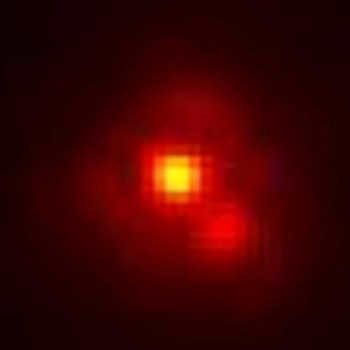
Beta constellation is the most prominent feature of this celestial pattern. It has a brightness level of 3.63m. The star is named Rotanev and is located 97 sv years away from the Sun. Beta Delphinus is a binary system consisting of two subgiants of spectral class F5. The distance between the two stars is very small, making it difficult to observe them with every telescope. The brighter component of the system has a luminosity 18 times greater than that of the Sun, while the less visible star has a luminosity 8 times greater than our Sun.
The components of the system have a rotational period of 26.7 years. Studies have shown that their masses are about 2.5 times greater than that of the Sun.
Alpha
The luminary mentioned above is slightly less bright than Saulocinus. It is a constellation known as Alpha and is also a binary system. The primary component of this system falls under the B9 spectral class. It is located approximately 240 light-years away from the Sun. A notable characteristic of stars in this category is their rapid rotation, with speeds near the equator reaching 160 km/s. This is about 70 times faster than the Sun’s rotation. Currently, scientists have not definitively determined the classification of Saulocin. Some data suggests that it belongs to the category of simple main-sequence stars, while other calculations point towards it being a subgiant in the early stages of its evolution.
The system’s second component is located 12 astronomical units apart from the first. It undergoes a rotation every 17 years. It seems that the Saulocinus satellite shares many similarities with Sirius.
Etymology
Unusually, the names of Alpha and Beta Delphinus are not derived from Arabic or Greek origins. These names were first documented in a catalog that was published in the early 19th century at the Palermo Observatory. Later on, British astronomer Thomas William Webb discovered that the names Saulocin and Rotanev, when read from right to left, spell out the name Nicolaus Venator. This was the name of the assistant to astronomer Piazzi Cacciatore. Whether Nicolaus himself or his superior came up with these names remains a mystery.
Fascinating artifacts
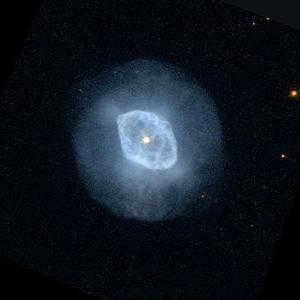
The Dolphin constellation is home to not only a few bright stars, but also some fascinating astronomical objects. Within its relatively small boundaries, you can find the nebulae NGC 6891 and NGC 6905, each with their own unique characteristics. NGC 6891 has a stellar magnitude of 11, while NGC 6905 has a slightly dimmer magnitude of 12. Both of these nebulae, much like the constellation itself, are relatively compact in size.
Adding to the beauty of the Dolphin constellation is the presence of the globular cluster NGC 6934, located near the epsilon star of this celestial pattern. This cluster is quite large and boasts a stellar magnitude of 8.9m. Another similar object, NGC 7006, is also considered to be quite bright. It is situated approximately 185 thousand light years away from Earth.
However, that is not the only fascinating aspect of the constellation Dolphin. Another intriguing object that adorns this constellation is New Delphinus 2013. A quick internet search will yield plenty of photos of this celestial wonder. What makes this object truly remarkable is its transformation from a dim, 17th magnitude star to a much brighter one. Amateur astronomer Koichi Itagaki made the discovery, and it was found that the star had suddenly become 25,000 times more luminous. Scientists believe that New Delphinus 2013 is likely a classical Nova, a type of binary system consisting of a white dwarf and a massive, cold star. The close proximity between the two stars causes matter from the larger star to flow onto the smaller one, resulting in heating and eventually an explosion. Remarkably, this explosive event leaves the stars themselves unharmed. These types of stars have the potential to erupt multiple times in their lifetimes.





